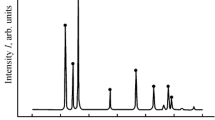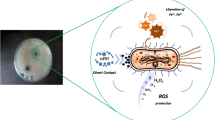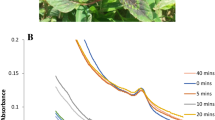Abstract
Copper and copper oxide nanoparticles are promising candidates for the role of “new antibiotics.” However, characteristics of their effect on microorganisms, depending on the nature of the dispersion medium and the time of storage of suspensions, have not been thoroughly studied, which limits the possibilities of application in practice. A comparative evaluation of the effects of freshly prepared and 24-h suspensions of copper and copper oxide nanoparticles (100 nm in size) on E. coli bacteria using the bioluminescence test is carried out. Distilled water and saline are used as dispersion media; the nanoparticle concentration is 1–0.0001 g/L. Significant differences in the antibacterial properties of freshly prepared suspensions of copper and copper oxide nanoparticles are revealed. Colloidal solutions of copper oxide in all studied concentrations have a significant toxic effect in both types of dispersion media (the survival rate of bacteria is less than 20–40%). An antibacterial effect is observed only at 1 g/L of copper nanoparticles (survival is less than 50%) in fresh aqueous dispersions and at 0.01–1 g/L in solutions based on saline (survival rate is 15–75%); i.e., in this case, the role of the dispersion medium is essential. The storage of solutions for 24 h results in a significant decrease in the toxicity of the colloid systems of copper oxide nanoparticles both in water and saline, while the antibacterial effect of suspensions of copper nanoparticles remains almost the same, regardless of the medium type. These phenomena can be caused by changes in the stability of colloidal systems accompanied by the aggregation of nanoparticles. These results indicate the importance of taking into account the nature of the dispersion medium and the time of storage of suspensions of copper-based nanoparticles for their efficient use as antimicrobial agents.
Similar content being viewed by others
References
M. Kolar, K. Urbanek, and T. Latal, “Antibiotic selective pressure and development of bacterial resistance,” Int. J. Antimicrob. Agents 17, 357–363 (2001).
Antibiotic Resistance Major Public Health Problem. http://www.medicalnewstoday.com/articles/252956.php
What is Antibiotic Resistance and why is it a Problem? Alliance for the Prudent Use of Antibiotics (APUA). http://www.tufts.edu/med/apua/about_issue/antibiotic_ res.shtml
“Atibiotic resistance reveals serious, worldwide threat to public health,” WHO Report (World Health Organization, 2014). http://www.who.int/mediacentre/ news/releases/2014/amr-report/ru/. Accessed July 10, 2014.
L. Wang, Ch. Hu, and L. Shao, “The antimicrobial activity of nanoparticles: present situation and prospects for the future,” Int. J Nanomed. 12, 1227–1249 (2017).
I. M. Gould and A. M. Bal, “New antibiotic agents in the pipeline and how they can overcome microbial resistance,” Virulence 4, 185–191 (2013).
G. D. Wright, “Something new: revisiting natural products in antibiotic drug discovery,” Can. J. Microbiol. 60, 147–154 (2014).
S. Sengupta, M. K. Chattopadhyay, and H. P. Grossart, “The multifaceted roles of antibiotics and antibiotic resistance in nature,” Front Microbiol. 4, 47 (2013).
Centers for Disease Control and Prevention, Office of Infectious Disease Antibiotic Resistance Threats in the United States, 2013. http://www.cdc.gov/drugresistance/ threat-report-2013. Accessed January 28, 2015.
F. C. Tenover, “Mechanisms of antimicrobial resistance in bacteria,” Am. J. Med. 119, 10 (2006).
A. Azam, A. S. Ahmed, M. Oves, M. S. Khan, S. S. Habib, and A. Memic, “Antimicrobial activity of metal oxide nanoparticles against gram-positive and gram-negative bacteria: a comparative study,” Int. J. Nanomed. 7, 6003–6009 (2012).
W. Liu, P. Su, S. Chen, N. Wang, Y. Ma, Y. Liu, J. Wang, Z. Zhang, H. Li, and T. J. Webster, “Synthesis of TiO2 nanotubes with ZnO nanoparticles to achieve antibacterial properties and stem cell compatibility,” Nanoscale 6, 9050–9062 (2014).
A. Besinis, T. de Peralta, and R. D. Handy, “The antibacterial effects of silver, titanium dioxide, and silica dioxide nanoparticles compared to the dental disinfectant chlorhexidine on streptococcus mutans using a suite of bioassays,” Nanotoxicology 8, 1–16 (2014).
C. Peng, W. Zhang, H. Gao, Y. Li, X. Tong, K. Li, X. Zhu, Y. Wang, and Y. Chen, “Behavior and potential impacts of metal-based engineered nanoparticles in aquatic environments,” Nanomaterials 22, 7 (2017).
Y. N. Slavin, J. Asnis, U. O. Hafeli, and H. Bach, “Metal nanoparticles: understanding the mechanisms behind antibacterial activity,” J. Nanobiotechnol. 15, 65 (2017).
M. J. Hajipour, K. M. Fromm, A. A. Ashkarran, D. Jimenez de Aberasturi, I. R. de Larramendi, T. Rojo, V. Serpooshan, W. J. Parak, and M. Mahmoudi, “Antibacterial properties of nanoparticles,” Trends Biotechnol. 30, 499–511 (2012).
G. V. Vimbela, S. M. Ngo, C. Fraze, L. Yang, and D. A. Stout, “Antibacterial properties and toxicity from metallic nanomaterials,” Int. J. Nanomed. 12, 3941–3965 (2017).
W. Zhang, Y. Li, J. Niu, and Y. Chen, “Photogeneration of reactive oxygen species on uncoated silver, gold, nickel, and silicon nanoparticles and their antibacterial effects,” Langmuir 29, 4647–4651 (2013).
R. Nieder, D. K. Benbi, and F. X. Reichl, “Microelements and their role in human health,” in Soil Components and Human Health (Springer, Dordrecht, 2018), pp. 317–374.
L. Prashanth, K. K. Kattapagari, R. T. Chitturi, V. R. R. Baddam, and L. K. Prasad, “A review on role of essential trace elements in health and disease,” J. Dr. NTR Univ. Health Sci. 4 (2), 75–85 (2015).
C. Gunawan, W. Y. Teoh, Ch. P. Marquis, and R. Amal, “Cytotoxic origin of copper(II) oxide nanoparticles: comparative studies with micron-sized particles, leachate, and metal salts,” ACS Nano 5, 7214–7225 (2011).
Ch. O. Dimkpa, A. Calder, D. W. Britt, J. E. McLean, and A. J. Anderson, “Responses of a soil bacterium, pseudomonas chlororaphis o6 to commercial metal oxide nanoparticles compared with responses to metal ions,” Environ. Pollut. 159, 1749–1756 (2011).
I. DeAlba-Montero, J. Guajardo-Pacheco, E. Morales-Sánchez, R. Araujo-Martínez, G. M. Loredo-Becerra, G. A. Martínez-Castañón, F. Ruiz, and M. E. Compeán Jasso, “Antimicrobial properties of copper nanoparticles and amino acid chelated copper nanoparticles produced by using a soya extract,” Bioinorg. Chem. Appl., 1064918 (2017).
A. Godymchuk, G. Frolov, A. Gusev, O. Zakharova, E. Yunda, D. Kuznetsov, and E. Kolesnikov, “Antibacterial properties of copper nanoparticle dispersions: influence of synthesis conditions and physicochemical characteristics,” IOP Conf. Ser.: Mater. Sci. Eng. 98, 012033 (2015).
O. V. Zakharova, A. Yu. Godymchuk, A. A. Gusev, S. I. Gulchenko, I. A. Vasyukova, and D. V. Kuznetsov, “Considerable variation of antibacterial activity of Cu nanoparticles suspensions depending on the storage time, dispersive medium, and particle sizes,” BioMed. Res. Int., 412530 (2015).
G. Ren, D. Hu, E. W. Cheng, M. A. Vargas-Reus, P. Reip, and R. P. Allaker, “Characterisation of copper oxide nanoparticles for antimicrobial applications,” Int. J. Antimicrob. Agents 33, 587–590 (2009).
Y. H. Hsueh, P. H. Tsai, and K. S. Lin, “PH-dependent antimicrobial properties of copper oxide nanoparticles in staphylococcus aureus,” Int. J. Mol. Sci. 8, 18 (2017).
A. Baranwal, A. Srivastava, P. Kumar, V. K. Bajpai, P. K. Maurya, and P. Chandra, “Prospects of nanostructure materials and their composites as antimicrobial agents,” Front Microbiol. 9, 422 (2018).
Disinfectant “Nika-khlor”. http://geniks.ru/catalog/ medical/hlors/
D. M. Diez, Ch. D. Barr, and C. R. Mine, OpenIntro Statistics, 3rd ed. (OpenIntro, 2017).
J. S. McQuillan and A. M. Shaw, “Differential gene regulation in the Ag nanoparticle and Ag(+)-induced silver stress response in escherichia coli: a full transcriptomic profile,” Nanotoxicology 8, 177–184 (2014).
D. Wang, Z. Lin, T. Wang, Z. Yao, M. Qin, S. Zheng, and W. Lu, “Where does the toxicity of metal oxide nanoparticles come from: the nanoparticles, the ions, or a combination of both?,” J. Hazard. Mater. 5, 328–334 (2016).
A. Y. Godymchuk, G. G. Savel’ev, and D. V. Gorbatenko, “Dissolution of copper nanopowders in inorganic biological media,” Russ. J. Gen. Chem. 80, 881–888 (2010).
S. Nair, A. Sasidharan, V. V. D. Rani, D. Menon, K. Manzoor, and S. Raina, “Role of size scale of ZnO nanoparticles and microparticles on toxicity toward bacteria and osteoblast cancer cells,” J. Mater. Sci. Mater. Med. 20, 235–241 (2009).
G. A. Martínez-Castañón, N. Nino-Martínez, F. Martínez-Gutierrez, J. R. Martínez-Mendoza, and F. Ruiz, “Synthesis and antibacterial activity of silver nanoparticles with different sizes,” J. Nanopart. Res. 10, 1343–1348 (2008).
H. L. Karlsson, J. Gustafsson, P. Cronholm, and L. Möller, “Sizedependent toxicity of metal oxide particles -a comparison between nano- and micrometer size,” Toxicol. Lett. 188, 112–118 (2009).
Author information
Authors and Affiliations
Corresponding author
Additional information
Original Russian Text © O.V. Zakharova, A.A. Gusev, Yu.V. Altabaeva, S.Yu. Perova, 2018, published in Rossiiskie Nanotekhnologii, 2018, Vol. 13, Nos. 3–4.
Rights and permissions
About this article
Cite this article
Zakharova, O.V., Gusev, A.A., Altabaeva, Y.V. et al. Biological Effects of Freshly Prepared and 24-h Aqueous Dispersions of Copper and Copper Oxide Nanoparticles on E. coli Bacteria. Nanotechnol Russia 13, 173–181 (2018). https://doi.org/10.1134/S1995078018020180
Received:
Accepted:
Published:
Issue Date:
DOI: https://doi.org/10.1134/S1995078018020180




